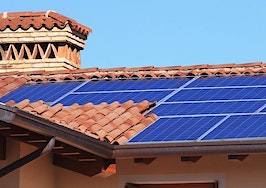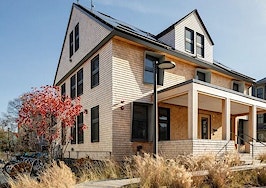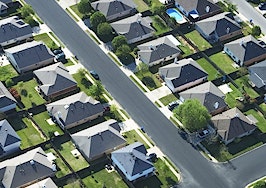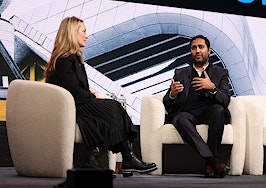Three years ago, longtime friends Bill Rehe and Michael Pressnall, with crude architectural sketches and piles of housing research in hand, met up at a local bar to chat about how they could alleviate the worsening affordability crisis in Tacoma, Washington, a city of roughly 200,000 people located 45 minutes south of Seattle.
Pressnall, who is vice president of industry relations for realtor.com, says the housing shortage from Seattle started to bleed into Tacoma, where home prices have risen 13.2 percent year-over-year. That sharp rise in home prices, he said, made homeownership effectively out of reach to the “people in the middle” whose wages weren’t low enough to qualify for highly-subsidized housing but weren’t high enough to buy a home at market rate.
“We missed out on 2 or 3 houses because during the bidding process, [the price] just keeps going up,” said Pressnall, reminiscing over the struggle he and his wife, Nichole, faced during their home search.
Rehe, an accomplished fisheries biologist and restoration ecologist, wanted to make sure the homes were not just affordable, but also sustainable and eco-friendly — a standard that naysayers said was impossible due to the higher costs usually associated with sustainably sourced, higher-quality building materials.
“We were basically laughed out of Gig Harbor,” said Rehe of the first location he and Pressnall scouted in 2015.

The Rehes and the Pressnalls.
Now, three years later, the duo along with their wives, Tiana and Nichole, have launched The Preserve, a 30-acre development in South Tacoma that will be home to at least 50 two and three-bedroom cottages exclusively for buyers with a total household income of no more than $75,000 and who work within 15 miles of the site.
The homes will be priced in the mid-$200,000 range, which is $50 to 75,000 under market value. Pressnall said they’re able to offer those prices thanks to a 99-year leasehold — the ownership of the land will continue to be held by Rehe and Pressnall’s Green Harbor Communities development group, and the buyers will own their homes and lease the land for $100 per month.
This, Pressnall says, removes the initial cost of the land from the overall purchase price and the cost of parceling the land out, thus lowering financial barrier for buyers.
“You apply, you get approved, and you’re in line [for a home],” Pressnall explained. “It’s on a first come, first approved basis.”
Although the first batch of eight to 12 homes won’t be constructed until spring 2019, buyers can fill out a short application on The Preserve’s website and begin the mortgage pre-approval process. Once approved, buyers can choose their lot and floor plan.
A private investor, who declined to be named, is footing the capital construction costs which are estimated to be at least $14.5 million, according to Pressnall.
Buyers will have two floor plans to choose from — a two-bedroom, 950-square-foot cottage or a three-bedroom, 1,250 square-foot cottage. Both options have structural insulated panels, Hardie fiber-cement siding, bamboo flooring, quartz countertops, metal roofing, and energy efficient appliances and heating and air systems.
According to Rehe and Pressnall, these options will reduce homeowners’ heating and cooling bills by 60 percent.
- The first option.
- The second option.
The homes will take up eight acres of land with the other 22 acres of wetlands being preserved for walking trails, bird watching, and a community learning lab where Tacoma Public Schools students can come and study the area’s ecosystem.
Beyond the beauty and educational opportunities the wetlands offer, Rehe, a fisheries biologist and restoration ecologist, says it also offers a practical benefit for homeowners. For example, the preservation of 65 percent of the tree canopy will help lower cooling costs and usage in the summer since the trees provide natural shade.
The first two model homes will be ready in January for walkthroughs, and the for-sale homes will begin construction by spring — a sweet victory for Rehe and Pressnall, who said it took a lot of planning, community organizing, listening and education to get this vision to fruition.

What The Preserve looks like now.
Before becoming The Preserve, the 30-acres of land was owned by the Tacoma Public School District and had never been developed.
After being turned away from Gig Harbor, a friend of Rehe’s suggested he reach out to TPSD about the land and see if they’d be willing to sell it.
School district officials liked the idea, said Rehe, but residents near the site weren’t so receptive since they’d been used to low traffic and scenic views. The last thing they wanted was to look out their windows and see a large apartment complex or multiplexes, he said.
“The first meeting we held for the neighbors didn’t go exactly the way we were hoping,” he said with a laugh.
So, Rehe and Pressnall started hosting community meetings where they explained their vision (individual cottages, beautifully designed and built, preservation of scenery), and took feedback from residents on how they could improve their plan.
Eventually, TPSD agreed to sell them the land in June for $427,500.
Tacoma councilperson Ryan Mello, who has worked with Rehe and Pressnall throughout the entire process, says the duo’s willingness to listen to the community is unmatched. For example, the team changed the location of the main entrance to alleviate concerns about increased car traffic alongside an existing neighborhood and instead used that space to improve pedestrian walkways, noted Mello.
He said they also increased the tree buffering to maintain a scenic view and chose a street grid that allowed them to have meandering roads, which added to the park-like setting community members said they wanted.
“It’s always an uphill battle, especially in a highly urbanized area, when someone proposes to convert open space,” Mello said. “It’s never easy, and it was a challenge from the get-go.”
Although a development like The Preserve isn’t ideal for every community facing housing shortages, Mello says he believes it was a great choice for Tacoma and can be replicated other cities that have space.
“Green Harbor Communities may not have discovered the Holy Grail for building affordable housing, but what they have done comes remarkably close,” he said.
“In an urban environment, I’m all in favor of maxing out the density and providing as much housing options because I think we have to make really good use of limited land,” Mello added. “But in this case, it’s an existing park so this is an example of when it’s highly wooded, there are lots of wetlands or other critical areas, but you can still provide a decent amount of density.”
Rehe and Pressnall are already looking to build more developments like The Preserve, and have had consultation requests from other developers who want to craft their own, eco-friendly and affordable housing communities.
“The intent is that this would be our flagship property, and we could then go out to other locations,” said Pressnall. “This isn’t a unique problem we’re facing in Tacoma, it’s everywhere.”













